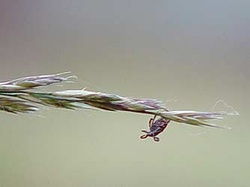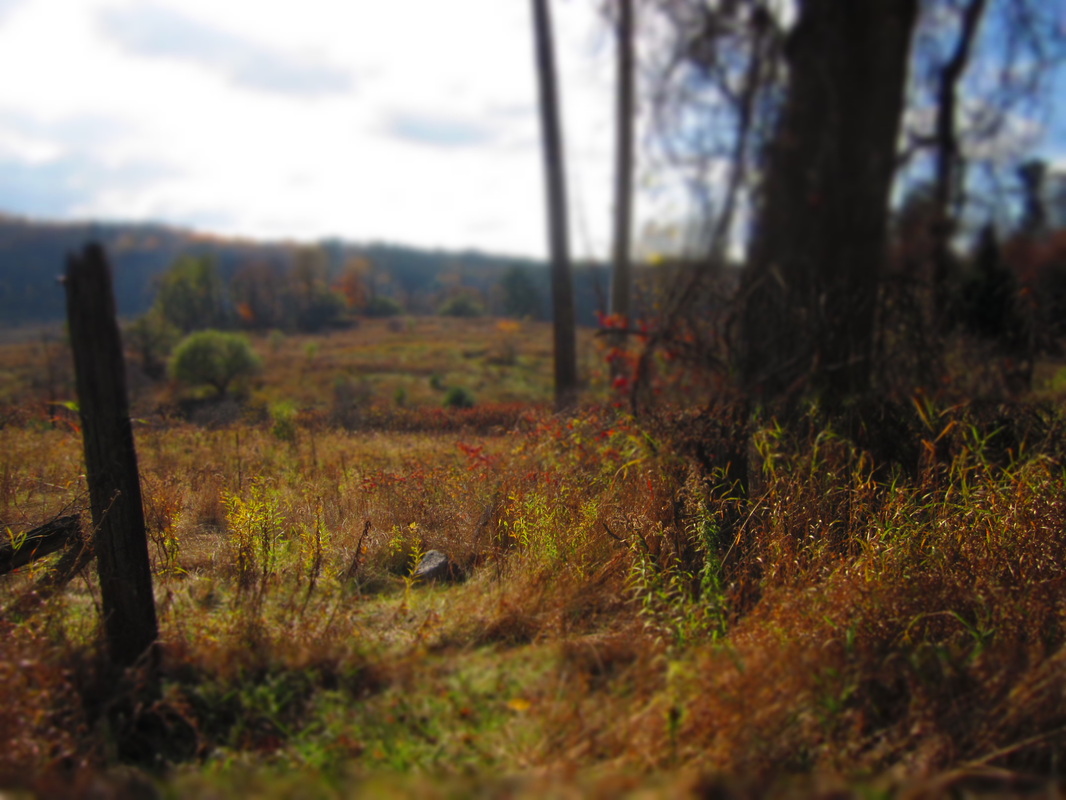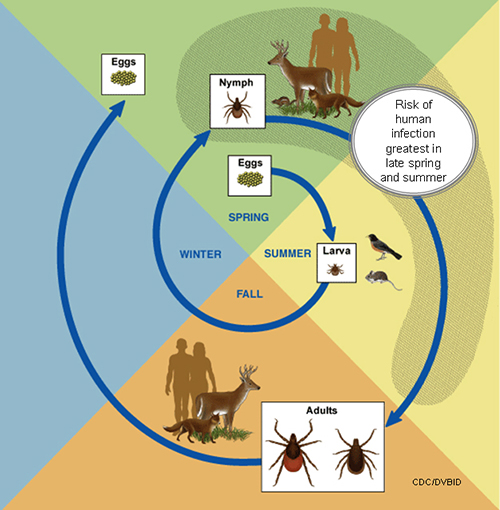Unfortunately, the incidence of Lyme in Ontario is projected to increase with the progression of time, the advancement of climate change, and the alteration of ecologies. The danger of Lyme is growing, and our understanding of both Lyme and tick ecology must outpace the danger if we are to stay healthy. This will be a fairly basic introduction to Lyme, and an explanation of tick-borne disease prevention strategy.
Lyme infection is a dreadful prospect. The full possibilities and ramifications of Lyme infection is a topic for another post, as is a full exploration of tick natural history. Suffice to say that it can have lifelong health implications, and causes some who are infected considerable physical pain, years-long disruptions in their life's path, and serious mental health issues. It is also important to emphasize that forsaking the woods does not mean that you will be safe from Lyme. Ticks make it into our homes on pets, clothing, and other family members.
So, what do we want? More information! When do we want it? Now! Should we stay out of the woods? Absolutely not! Should we stop taking naps in deer beds? Maybe!...Probably!...That's weird! Knowledge is power, everyone, so bear with me as I undertake this initial foray into the world of Lyme.
Though a handful of ticks are known to carry Borrelia spp., it is not known whether all ticks can transmit the disease to humans. Deer or blacklegged ticks (Ixodes scapuleris) are known and frequent transmitters of Lyme. Despite the uncertainty regarding Lyme transmission, ticks carry a variety of diseases and all tick species should be regarded with caution and an eye to prevention. Western Black-legged ticks (Ixodes pacificus), Ixodes angustus, Lone Star Ticks (Amblyomma americanum), American Dog Tick (Dermacentor variables), Brown Dog Tick (Rhipicephalus sanguineus), and Rocky Mountain Wood Tick (Dermacentor andersoni) are all found or suspected to occur in parts of Canada, and all carry a variety of diseases. It is impossible to tell if a tick is carrying a disease by looking at it. Health Canada estimates that about 10% of I. scapularis ticks in an infected area carry Lyme.
Lyme is the most common vector-borne disease occurring in the US, with the US Centers for Disease Control and Prevention receiving about 20,000 new reports of Lyme disease per year, a figure it estimates represents only 10% of the actual infection rate. It is also very much on the radar of the government of Canada. Physicians in Canada have been required since 2009 to report all confirmed cases of Lyme disease to the Public Health Agency. Elizabeth May, leader of the Green Party, recently authored a bill calling for a National Lyme Disease Strategy, Bill C-442.
Receiving even a diagnosis of Lyme disease can be difficult. It is a poorly understood disease, and some sufferers feel that it is often out of sight and out of mind of the mainstream medical system. Unfortunately, if Lyme goes untreated, sufferers can experience serious effects, including neurological symptoms and arthritis. It can also mess with your heart, and not in the way that they write country songs about. Though maybe they should.
Diagnosis of Lyme is often based on symptoms, the best-known and most definitive of which is the development of a bull's eye shaped rash around the bite area. Typical symptoms are often described as 'flu-like': fever, chills, headache, joint and muscle pain, swollen lymph nodes, fatigue, mental fog. Lyme disease can also mascarade as depression. Unfortunately, not everyone develops the diagnostic bull's eye rash, and 'flu-like' symptoms or bouts of depression are easily attributed to a bevy of other complaints. Symptoms generally appear within 30 days of a fateful tick bite. There are blood tests available to diagnose Lyme, but their efficacy depends on the stage of the disease. During the first weeks of infection, false negatives are common. These blood tests detect the presence of Lyme antibodies produced by the immune system.
It is speculated that diagnosis and treatment of Lyme is also complicated by its interactions with other tick-borne diseases. Ticks carry a variety of delights for our enjoyment, such as Human granulocytic anaplasmosis, Human babesiosis, tularaemia, Rocky mountain spotted fever, Human monocytic ehrlichiosis, Powassan encephalitis virus, and, in the case of Lone Star ticks, Southern Tick-Associated Rash Illness (STARI).
The Centers for Disease Control and Prevention advise that a blacklegged tick must be attached for 24 hours before transmission of Lyme to the host takes place. However, other tick-borne diseases may be transmitted in a shorter time. The shorter the tick's stay, obviously, the better, but if a tick has been embedded for only a short time, the risk of Lyme transmission is thought to be very low. This is why tick checks, morning and evening, is such important and effective Lyme prevention.
Treatment of Lyme disease often involves courses of antibiotics ranging from a few days to months, depending on the promptness of the diagnosis and the stage of the disease. Herbal protocols have also been developed, as well as a host of other alternative treatments. However, treatment and diagnosis is not always straightforward, and prevention is by far the best strategy.
Though some tick species (such as the Lone Star tick) are historically confined to ranges south or west of Ontario, range expansion has occurred dramatically in recent years, especially that of the blacklegged or deer tick. It is widely speculated that range expansion will only accelerate in coming decades, as well as the population density of tick species and the incidence of tick-borne diseases. And though it is a relatively new concern, and perhaps feeling like a rather distant threat, habits like tick-checks should be in place before Lyme reaches a state of crisis in Ontario.
 courtesy of http://www.bentler.us
courtesy of http://www.bentler.us Tick Safety Protocol
• Between the toes
• Behind the knees
• Groin
• Belly Button
• Under breasts
• In the armpits
• Behind the ears
• At the nape of the neck
• On the scalp
• In facial hair.
During a tick check, make sure to have bright lighting. It can be helpful to spread a white sheet to stand on. Check or toss your clothing in the wash before or after checking your body. Pets, and non-washable items like shoes and outerwear should also be checked after excursions outside.
If you find a tick on yourself or a loved one, it is essential to remove it in its entirety and preserve it in a ziploc bag or container, preferably in the freezer. If the bitten party develops any symptoms within the next 30 days, the tick can be submitted for analysis. The less stressed and damaged the tick, the better. Health Canada will not analyze ticks missing their mouthparts, a part that is often detached with tweezer removal. Please keep in mind that tick testing is effective in determining whether a tick carries Lyme, but is useless in determining whether transmission took place.
Yanking on an attached tick, applying hot matches, petroleum jelly, nail polish remover, insecticides, etc. can cause the tick to regurgitate more infected fluids into the host, and damage the tick, making it impossible to analyze. Tick keys or spoons are painless and effective tools to remove ticks without damage, and are often sold at veterinary offices.
For more perspective on ticks and Lyme, please see the following resource list, and consider arming yourself with more information. However, it is important to approach information on Lyme with a degree of caution; because it is so frightening, and as yet poorly understood, some information out there can be misleading, and downright contradictory. What we do know for sure is that prevention is possible with the acquisition of some new habits. If you have any other goldmines of Lyme and tick info (or notice any mistakes I've made!) please share them around via the comment section!
 Tick awareness at fashion week!
Tick awareness at fashion week! Resources:
Perspective:
http://www.newyorker.com/reporting/2013/07/01/130701fa_fact_specter
http://www.newyorker.com/online/blogs/elements/2013/08/an-update-from-the-frontline-of-the-lyme-wars.html
Basic info:
http://www.cdc.gov/lyme/faq/
http://www.phac-aspc.gc.ca/id-mi/tickinfo-eng.php
http://canlyme.com/
Tick ID:
http://canlyme.com/lyme-basics/tick-id/
http://www.gov.mb.ca/health/lyme/blacklegged.html
Advanced Study:
http://www.amazon.ca/Lyme-Disease-Ecology-Complex-System/dp/0199928479/ref=sr_1_1?ie=UTF8&qid=1381953069&sr=8-1&keywords=lyme%3A+ecology+of+a+complex+system
Bill C-442:
http://www.parl.gc.ca/HousePublications/Publication.aspx?Language=E&Mode=1&DocId=5696477
http://www.parl.gc.ca/LegisInfo/BillDetails.aspx?Language=E&Mode=1&Bill=C442&Parl=41&Ses=1


 RSS Feed
RSS Feed